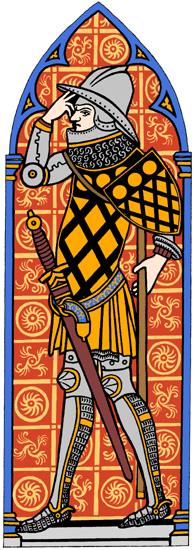 |
 |
|||
|
|
Almaric (or Amaury) was the son of John, Lord St. Amand, and his wife, Margaret, the daughter of Hugh Le Despenser, Earl of Winchester. He was named after his uncle, the 1st Lord St. Amand. He was only fifteen when his father died and so became a Royal ward. He was, however, already married, to Joan, the daughter of Sir John Handlo. Two years later, while still under age, he received orders from Edward III to join him in Ireland in order to defend his estates there. However, several lords were so called upon and yet none of them seem to have complied. Almaric did homage for and took possession of his estates on 16th March 1335. By February 1337, he had been knighted and, in that same year, accompanied the 1st Earl of Salisbury on his embassy to King Philip VI of France. They declared King Edward's claim to the French Throne and subsequently toured the Royal courts of Germany in an attempt to organise an anti-French league. The following year, he served in Scotland. From his residence at West Woodhay, Almeric was appointed the Commissioner of Array for Berkshire in both 1338 and 1339. By 1342, however, he was serving in the English army abroad again, this time in the French Wars under the Earl of Warwick. He was in the 1st division at the Battle of Crecy and also served at the subsequent the Siege of Calais (1346). He was given a pension of £200 a year for his good service there. Meanwhile, Almaric had also spent some time in England, acting as commissioner for peace in Oxfordshire in 1344 and commissioner for the array of archers in Bedfordshire, two years later. In 1355 and 1357, he fought in the abortive Scottish Campaign under Sir Robert Herle. Almaric was Lord of Gormanstown in Meath and, on 14th July 1357, he succeeded Sir Thomas Rokeby as Justiciar of all Ireland, for which position he was assigned a hundred mounted archers and paid £500 a year. He served in Ireland for nearly two years, but resigned his post on 16th February 1359 upon returning to England. Back at home, Lord St. Amand was made Commissioner of the Peace for Berkshire in 1361, a position he held for the next twenty years. His Irish expertise led to him participating in the Irish Affairs Council on 15th March 1361. He served his Royal master again in France during 1368 and, the following year, represented the King as one of the guarantors for the renewal of peace in Scotland. The same year, he was appointed Captain and keeper of Southampton and, in 1373, he became Steward of Rockingham Castle as well. He subsequently entered into semi-retirement, concentrating on his judicial and parliamentary obligations. In 1375, he was commissioned to look into and reform abuses at St. Frideswide's Priory in Oxford. The following year, he was JP for Buckinghamshire, and in 1382, for Bedfordshire and Berkshire. He also attended parliaments from 1371 until his death, on 11th September 1381. He was succeeded in his title and his estates by his son and heir, Almaric, the last of the St. Amand line.
|
|||
| © Nash Ford Publishing 2006. All Rights Reserved. | ||||



 Almaric
St. Amand Junior (1314-1381)
Almaric
St. Amand Junior (1314-1381)